Taking your children’s education to sea is not always simple, but neither is it a deeply complicated mystery.
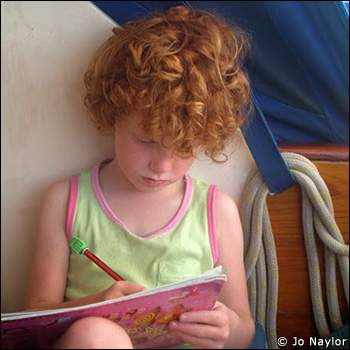 |
| Once you capture a child’s interest, learning can be inspiring and fun. |
With careful decision-making and sensible preparations – just what you need for going cruising in general – you can let your children profit from an incredible learning opportunity.
Just look at any of the inspiring stories of families interviewed by Women and Cruising!
Yes, it does add an extra task to the cycle of watches, meal preparation, and boat maintenance, but home schooling in such a unique situation can also be rewarding for parents and children alike.
You don’t have to be setting off on a circumnavigation to think about educating afloat. A summer cruise has endless possibilities, too! Often we think of education as something that happens in a school building, but education should be everywhere, every day.
In the words of Mark Twain: “I never let my schooling interfere with my education!”
The tips below will get you on your way. Take a breath, then take the plunge!
1. Keep it connected
The beauty of education on board is the opportunity for authentic, hands-on learning experiences. Snorkel on a reef, or study dolphins! Go to a history museum, then sail in the wake of explorers and settlers.
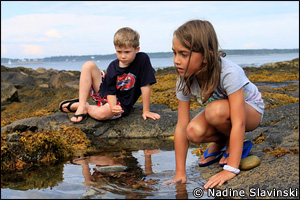 |
| A field trip to tidal pools can be educational AND fun! |
Even if you choose to follow a packaged home-schooling program (see below), make sure your children are connected to the world around them.
- What phase is the moon in?
- When is the next high tide?
- What causes these phenomena?
A child’s natural curiosity can be kindled with only a small hint, and you’re off on an interesting lesson!
If your line lands a fish, take the time for a biology session before cooking it up. Later, link the experience to a lesson in animal adaptations or human physiology. This might be a more traditional lesson, but the student will be much more engaged now that he or she has had the fish dissection as a lead-in.
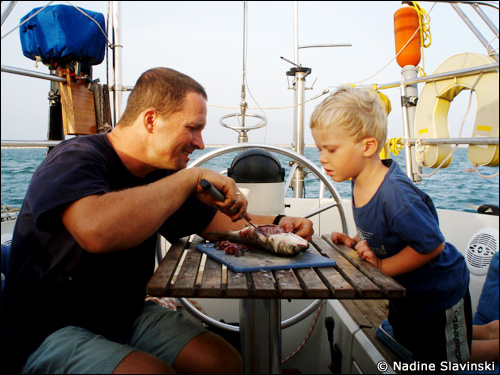 |
| Fish dissection |
These are just a few examples.
As a parent-teacher, you will quickly learn to identify and make the most of teachable moments. Underway and at exotic landfalls, you will find endless opportunities.
It does, however, require some finesse to shape a general interest lesson into one that also develops critical skills (more on this below).
2. Choose carefully
Early on, carefully consider what type of learning program will suit your family best.
Home schooling packages such as that offered by the Calvert School are one convenient option.
The advantages of these are the learning-by-numbers security they offer parent-teachers; all the planning is done, all the materials provided, and some degree of professional support is often included.
Just by going to sea, however, you are taking yourself out of a cookie-cutter mold, so consider whether you want to use cookie-cutter learning for your kids.
Packaged programs often include irrelevant or impractical lessons, such as complicated science experiments unsuited to a rocking platform, or topics like the Industrial Revolution. Try getting your kids excited about that in, say, the Bahamas!
Other families create their own curriculum to suit their realities.
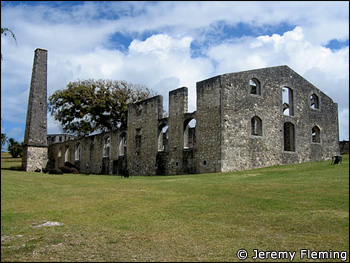 |
| Visiting a plantation such as Marie Galante’s Chateau de Murat can be the centerpiece of an interdisciplinary unit on the Atlantic slave trade. |
Colonization and slavery are chapters of history that can be covered well in the Caribbean, and physics lessons can be found all over the boat.
Learning can be completely student-centered, but you will be on your own in terms of materials, a problem that can be overcome with thorough research.
The greatest pitfall of independent design is the danger of leaving out difficult or inconvenient topics that are nevertheless critical to developing literacy and numeracy skills.
I met one sailing family whose incredibly intelligent boys could quote extensive passages from Homer but not write a full sentence at age ten. This is an extreme example, but the danger is there for well-meaning, loving parents who subtly transfer their own passions to their children while sweeping their weaknesses under the carpet.
You can avoid this trap by following the standards from your home school district and refer to them periodically: have we covered the depth and breadth of this curriculum? Did we practice all the required math and science skills?
Families with two or more children should consider what their choice of program means in practical terms.
If you use packaged programs, your children will be following unrelated strands of work. That creates quite the juggling act for the parent-teacher.
With a more independent approach, you can create a one-room schoolhouse in which everyone tackles the same topics but at different levels. While the youngest tracks his or her own water consumption and learns to make simple pictographs, the oldest can track overall water consumption on board and learn about graphic displays such as line graphs or pie charts. You will still be managing a circus, but at least all the action is in one ring!
A number of useful resources exist for those who take home schooling to sea. I have compiled many on a website, www.sailkidsed.net, including links to curriculum documents and a list of useful books and educational websites.
3. Do Your Homework
Whatever type of learning program you decide upon, you will have to prepare well, just as you must prepare your boat well for your cruise.
One important consideration will be your eventual plans:
- Will you come back home or do you plan to settle elsewhere?
- What are the curricula of those school systems?
- Will they demand to see an official transcript to place your child?
Most school districts provide full curricular documents online, and you will be able to download a list of standards, benchmarks and/or learning outcomes for every subject area and grade (these detail what your child should be able to do at the end of each unit in each grade level).
I am firm believer that parents who home school their children must conscientiously use such standards to guide their work. This requires some finesse, as the following examples demonstrate, but you will develop a knack for it.
Let’s say the kids are excited about volcanoes.In many prime sailing destinations, you will be among active, inactive, or extinct volcanoes, so conducting a basic lesson in volcanoes and geology will be easy.
Now check your list of standards for literacy and mathematics. How can you pull those in? - Take Virginia’s Grade 2 literacy standards, which include: “The student will write stories, letters, and simple explanations.” That means step two is writing an explanation of how volcanoes work, including self-editing and details like: “Use correct spelling for high-frequency sight words, including compound words and regular plurals.” - Now check the math standards, where you will find: “The student, given grid paper, will estimate and then count the number of square units needed to cover a given surface in order to determine area.”Adapt this by using a map and estimating the area your local volcano occupies. In this way, you encourage your child’s interests and keep learning real while developing subject-specific skills. |
Print out complete curriculum documents and stock up on books and materials before setting off. You might be able to purchase textbooks used by the relevant school system and use them either in a traditional approach or within your own tailor-made program.
The difficulty here is in knowing what is useful and what is not before you actually set sail. Sorry, there is no easy answer here!
4. Keep it Fun
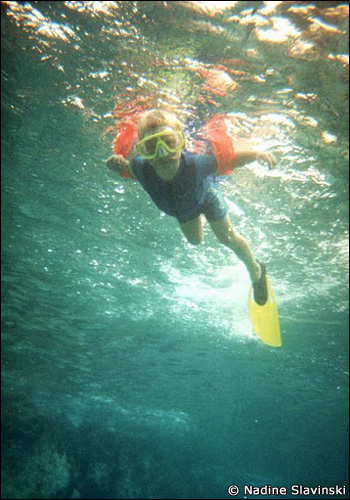 |
| The world is your classroom! By using clear learning goals, you can ensure that field trips are valuable learning experiences that spark ongoing interest. |
Learning can be fun!
If you find yourself locked below decks slaving over dull exercises on a regular basis, something is wrong.
It’s time to take a field trip – a proper field trip, armed with field guides, notebooks, and clear learning goals. Move your classroom to the foredeck or the beach occasionally. Spice up your child’s learning with fun exercises in a context your child can relate to.
If your learning program calls for writing a fictional story, great! Challenge your child to write a pirate story based on your sailing area with him or herself as one of the characters. Linking subjects is another way to make learning fun.
The pirate story could be set against the backdrop of a certain period in history, and it could sneak in a little math with a problem leading to the location of the hidden treasure chest.
Another example is to collect and identify shells, and then incorporate them in an art project. The list can go on and on.
If you treat learning as a heavy chore, your children will echo this attitude and everyone will suffer.
On the other hand, if you can establish a playful yet disciplined spirit and stimulate natural curiosity, learning will become an accepted part of your day and one of the richest points of the cruising experience.
5. Share the Load
Too often, Dad is the captain with Mom doing everything else: childcare, cooking, and, last but not least, teaching. A certain degree of division of labor is natural, but too much can put unfair strain on either partner.
With both parents sharing the teaching load to at least some degree, children can benefit from the strengths of each and from two different teaching styles. Not only that, they are more likely to accept education as a whole-family endeavor, just as the cruise should be a whole-family adventure.
6. Stop Worrying!
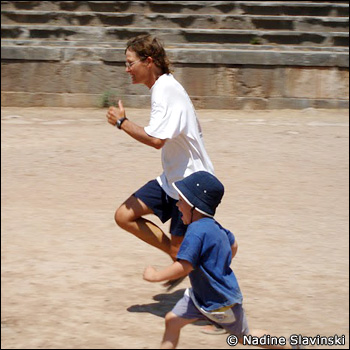 |
| Another inspirational way to kick off a learning unit: the author and her son race in ancient Delphi’s stadium, Greece. |
Just thinking about taking over your children’s schooling can be intimidating, much like sailing away to unfamiliar waters. Don’t get put off by doubts or by land-bound naysayers.
Countless families report that cruising with children is the best thing they have ever done, emphasizing the family time and eye-opening experiences their children benefit from.
Many also report that their children successfully streamline back into schools when the time comes, often academically ahead of their peers.
The truth is that cruising on a well-maintained boat can be safer and healthier than staying on land. Consider highway safety, or the germ breeding ground that schools can be.
Similarly, home schooling that is based on sound research and focused on clear goals can supersede what any walled classroom could ever offer.
The hardest thing is making the decision to go in the first place; after that, you will find that everything falls into place. Your children will enjoy the experience of a lifetime with the people who count most: their parents. And the lessons learned will guide them for a lifetime.
About Nadine Slavinski
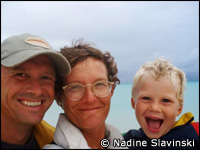
Nadine Slavinski is the author of Lesson Plans Ahoy: Hands-On Learning for Sailing Children and Home Schooling Sailors.
A teacher, parent, and a lifelong sailor, she holds a Master’s of Education from Harvard University. In 2007-2008, Nadine took a year-long sabbatical on her 35-foot sloop with her husband and four-year-old son, crossing the Atlantic and cruising the Mediterranean, Caribbean, and eastern U.S. seaboard. She is the author of four books and has written for numerous publications.
Her website, www.sailkidsed.net lists many free resources for home schooling sailors.
LESSON PLANS AHOY!
Lesson Plans Ahoy! is a resource for sailors heading out on a short cruise, an ocean crossing, or a year of home schooling.
The book includes detailed instructions for six units in Science, Mathematics, the Humanities, and Physical Education; all are designed to be fun, practical, and relevant.
Lesson Plans Ahoy! is highly recommended to any parent considering cruising with school-aged children and available at major booksellers including Amazon.com
.
Each unit includes information on:
- Materials required (selected for practicality on a boat)
- Age-appropriate adaptations (ages 4-12 in detail)
- Activities and assignments children will enjoy doing
- Tips for cross-curricular links and enrichment
- Suggested resources to support learning
An appendix links science and mathematics units to national and state curricula for ages 4-12 from the United States, Canada, Australia, and the UK so that home schooling students can keep pace with expectations in their home systems.
Read also on this website
- Nadine SLAVINSKI answers 12 questions on sailing as a family aboard NAMANI
- 12 questions to 12 sailing families
- What does it cost to cruise as a family? One family’s first-year expenses, by Meri Faulkner
More information (external links)
- Nadine’s book: Lesson Plans Ahoy (Second Edition): Hands-On Learning for Sailing Children and Home Schooling Sailors is available at Amazon.com
- Nadine’s educational website for sailing families: www.sailkidsed.net
How do you handle home schooling aboard your boat? Do you have advice or tips for other families?
Let us know.
Email kathy@forcruisers.com or leave a comment below.
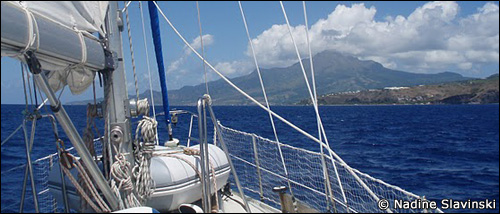

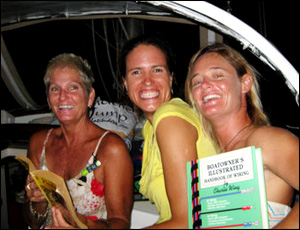
Hey, just read Nadine’s home schooling piece. Not sure how I missed it before, but it is terrific. It is exactly what I felt was missing from the “Families Project”…specific “how-to’s” when the parents kept talking about designing their own curriculum. People forget that those of us who have never been teachers really have little clue where to start! Can we put a link to this on the Families page? Or on Resources. Or on a “Topics” link? It’s stimulating! I want a copy of Lesson Plans Ahoy for myself, for thinking about ways to interact with my grandson!
And yes, I will order it thru women and Cruising.com’s Bookstore link to Amazon!!
http://worldwideopenmind.wordpress.com
How helpful: Awesome !
Thank you for the tips! I used to be a 4th grade school teacher and it is much less overwhelming to think of developing a curriculum for younger kids than for highschoolers. We are doing this in what is probably reverse order for most familes. My son has been in public school all his life and we now want to sail and homeschool during his highschool years. I tend to think packaged learning is better at his age, but I agree whole-heartedly with your statement about parting with the cookie cutter education.
Awesome information. We are just getting started and still have a lot to learn. We also have to figure out the homeschooling piece. Trying not to worry about it.
5kidsandaboat.com